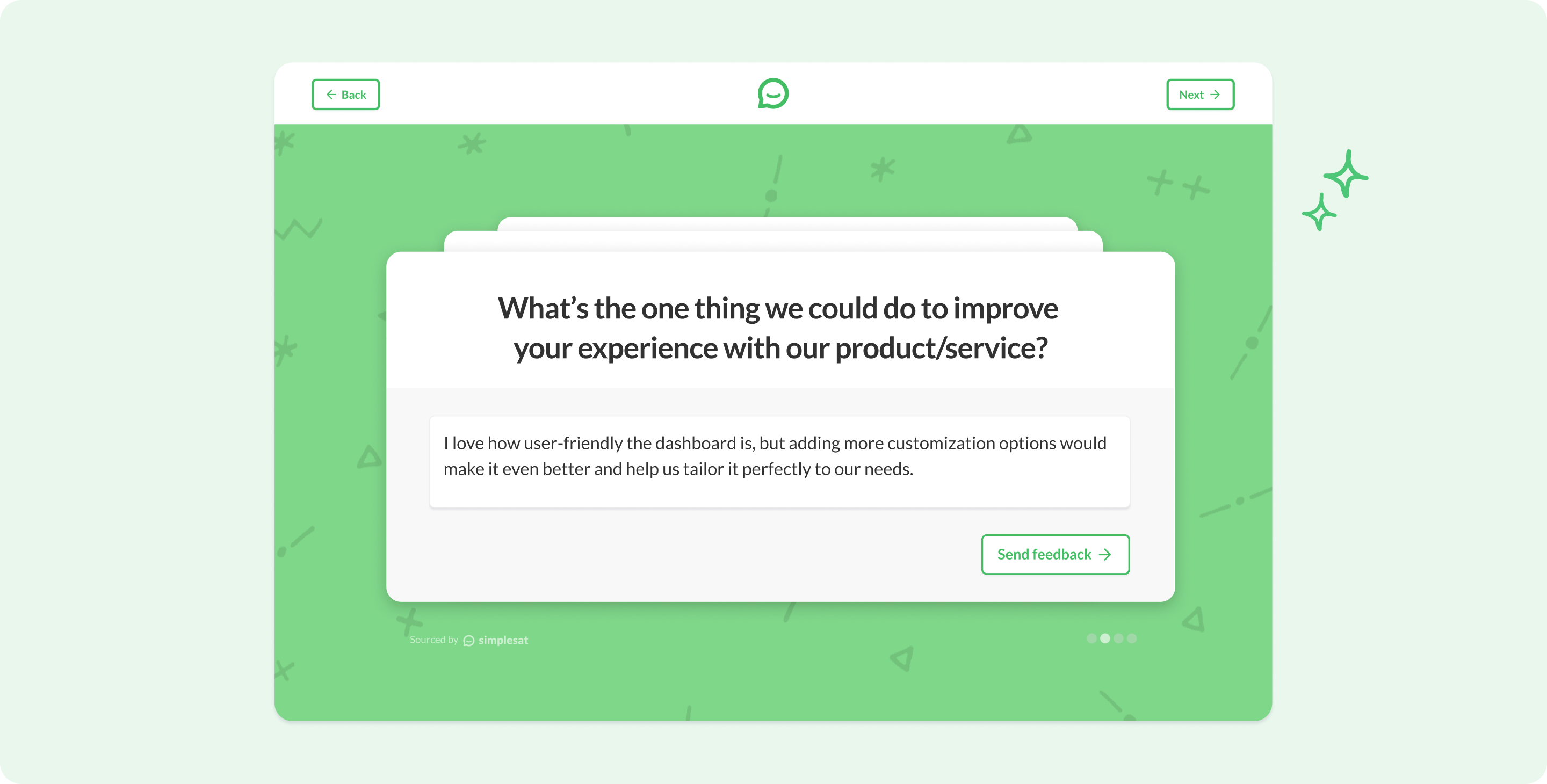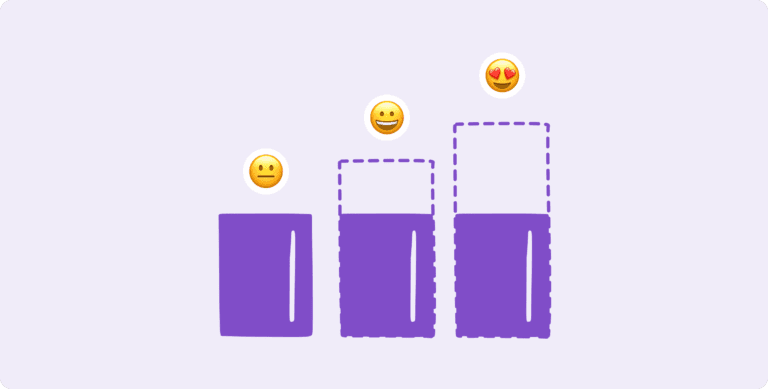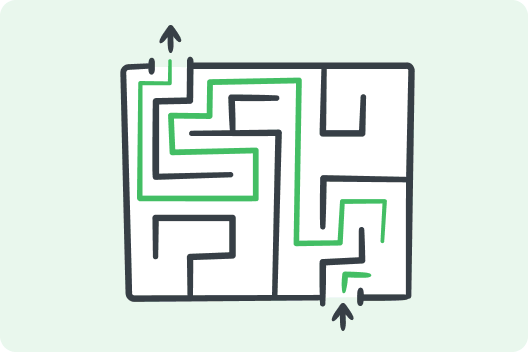Customer feedback is a vital component of business success, and open-ended questions are an extremely effective way of soliciting feedback.
These survey questions can help your organization go beyond superficial metrics. They uncover valuable insights into customer needs and behaviors.
Let’s take a quick look at the definition and meaning of open-ended questions in the context of customer surveys. We’ll also discuss how they compare to closed-ended questions, and highlight best practices.
Open-ended questions — definition and meaning
An open-ended question invites respondents to provide detailed, qualitative responses. Using this question type encourages customers to elaborate on their thoughts, experiences, and feelings.
The true meaning of open-ended questions lies in their ability to capture unique experiences. No two customers have the exact same reaction to your brand, and an open-ended question lets you explore those nuances. This provides a depth of understanding that numerical ratings or checkboxes just can’t offer.
Examples of open-ended questions
- “What do you like most about our product or service?”
- “Can you describe a recent experience where we exceeded your expectations?”
- “What suggestions do you have for improving our service?”
- “What motivated you to choose our brand over others?”
- “Can you tell us about a challenge you faced while using our service?”
- “What additional features would make our product more useful to you?”
Recommended reading: All you need to know about customer survey questions
Open-ended vs. closed-ended questions
To fully leverage open-ended questions in customer surveys, it’s crucial to distinguish them from closed-ended questions.
What is a closed-ended question?
A closed-ended question seeks specific answers and is often used for quantitative analysis. These questions typically include predefined options, such as “Yes,” “No,” or a multiple-choice format:
- “How likely are you to recommend us?” (Scale: 1–10)
- “Which of these features do you use the most?” (Options: A, B, C, D)
Open-ended questions vs. closed-ended questions in customer surveys
| Feature | Open-ended questions | Closed-ended questions |
|---|---|---|
| Answer type | Descriptive, detailed | Concise, specific |
| Purpose | Explore opinions, experiences, and emotions | Quantify satisfaction, preferences, or behaviors |
| Use case | Uncover hidden insights, generate new ideas | Measure performance or compare metrics |
| Examples | "What improvements would you like to see in our product?" | "Are you satisfied with our product?" |
| Upsides | Makes the customer feel heard, reveals nuanced preferences | Quick to fill out, offers an objective measure you can track over time |
| Downsides | It’s too easy to phrase it in a leading or biased way | Doesn’t delve into the root of customer issues |
Why are open-ended questions important?
🔎 Gain deep customer insights
Open-ended questions allow customers to express themselves fully, providing details that can reveal unmet needs, pain points, or areas for innovation. Through their own words, customers provide valuable emotional context, which can show your team what to focus on.
💡 Identify unique opportunities
Customers often share creative ideas or unexpected suggestions when prompted with open-ended questions. This could help you stay ahead of the competition.
💞 Enhance customer engagement
Allowing customers to voice their opinions fosters a sense of inclusion and builds trust. When you demonstrate that their input is valued, and you follow up on their complaints, you demonstrate real, meaningful commitment to excellent service.
When to use open-ended questions in customer surveys
Qualitative insights can be a part of most types of customer feedback.
Customer satisfaction surveys
- Example question: “What did you enjoy most about your experience with us?”
- Purpose: To uncover specific aspects of the customer journey that create satisfaction.
Post-purchase feedback
- Example question: “What could we do to make the purchasing process smoother?”
- Purpose: To refine and optimize the buying experience.
Product development research
- Example question: “What features would you like to see in future updates?”
- Purpose: To align product development with customer needs.
Churn analysis
- Example question: “Can you share why you decided to stop using our service?”
- Purpose: To identify and address reasons for customer attrition.
Recommended reading: Uncover the reasons behind customer churn
Best practices for crafting open-ended questions in surveys
Creating effective open-ended questions requires thoughtful consideration. Poorly crafted questions may lead to ambiguous or irrelevant responses, and there’s even a risk of creating animosity in the customer if your question feels glib or manipulative.
Here is how you can avoid those pitfalls:
1️⃣ Be specific yet open
Avoid overly broad questions that can confuse respondents. Instead, guide them with enough context to generate relevant answers.
- Too broad: “What do you think?”
- Better: “What do you think of the way we handle customer complaints?”
2️⃣ Avoid leading questions
Aim for neutrality to allow authentic feedback.
- Leading: “Why do you love our product?”
- Better: “How would you describe your experience with our product?”
3️⃣ Encourage detail
Prompt respondents to provide rich, detailed answers by using phrases like “Can you describe,” “What specifically,” or “How do you feel about.”
- Example: “Can you describe a situation where our service met or exceeded your expectations?”
4️⃣ Limit the number of open-ended questions
Open-ended questions require more effort, which may deter some respondents. Balancing their inclusion with easier questions is key. You should also make sure it’s easy to skip these questions without losing previous response data.
5️⃣ Analyze responses effectively
Use tools or methodologies to analyze qualitative data from open-ended questions. For example, Simplesat’s Topics feature automatically categorizes write-in responses based on mood or subject-matter.
More open-ended question examples — a comment prompt for every occasion
Here are some expanded examples of open-ended questions tailored to a variety of survey goals. These questions can help uncover deeper insights across multiple facets of your business.
Customer experience
- “What aspects of our service impressed you the most?”
- “Can you describe a time when you felt disappointed with your experience?”
- “How do you feel about the timeliness of our support?”
- “What changes would make our service more convenient for you?”
Product feedback
- “What features do you find most useful in our product?”
- “Can you describe a feature that you think is missing from our product?”
- “How has our product helped you achieve your goals?”
- “What challenges have you encountered while using our product?”
- “If you could change one thing about our product, what would it be?”
Brand perception
- “How does our brand compare to others in the industry?”
- “What emotions do you associate with our brand?”
- “What do you think sets us apart from our competitors?”
Customer loyalty
- “What keeps you coming back to use our services or products?”
- “What could we do to make you feel more valued as a customer?”
- “What specific benefits do you see in continuing to work with us?”
- “Can you share a story about why you remain loyal to our brand?”
Marketing effectiveness
- “What social media content from us resonates most with you?”
- “Are there any campaigns or messages from us that you remember particularly well?”
- “How could we improve the way we communicate our value to you?”
Website or app usability
- “What was your first impression of our website or app?”
- “What challenges did you encounter while navigating our website or app?”
- “How easy was it to find the information or product you were looking for?”
- “What features of our app or website do you find most useful?”
- “How could we improve your experience with our website or app?”
Post-event feedback (e.g., webinars, workshops, conferences)
- “What did you find most valuable about the event?”
- “Were there any topics or sessions that you felt could have been improved?”
- “What key takeaway did you gain from attending this event?”
Recommended reading: All you need to know about post-event surveys
Customer retention and churn analysis
- “What caused you to stop using our service?”
- “What changes would make you consider coming back?”
- “What factors made you decide to leave us for another brand?”
- “What improvements could we make to better meet your expectations?”
- “Can you describe what initially attracted you to our service and how that changed over time?”
The power of listening
Open-ended questions are more than just a survey tool—they are an invitation to truly listen to your customers. They provide a way for people to share their stories, frustrations, and aspirations in their own words, offering insights you might never uncover with a simple checkbox.
When you ask a customer, “What could we do better?” and genuinely act on their feedback, you’re not just improving your service—you’re building trust and loyalty that no marketing campaign can replicate. By making customers feel heard, you turn a survey into a conversation and a brand interaction into a relationship.
About Simplesat: Simplesat is the leading omnichannel survey app designed to enhance customer feedback management across various platforms, including Zendesk. Trusted by businesses worldwide, Simplesat delivers actionable insights that drive business growth and customer satisfaction.









